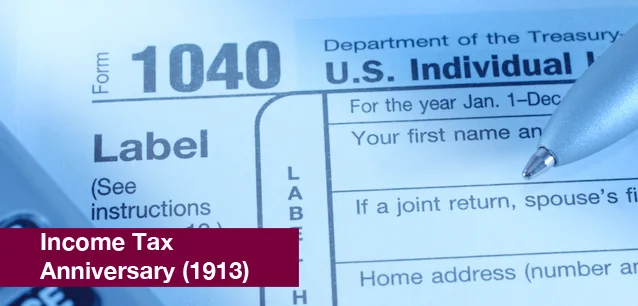 AD
AD
Today is: November 05
Scroll to explore events active on this date.
Additional Events on LEEP
LEEP INK FEATURES

August? Absolutely!
In August, we live through the Dog Days of Summer. It's hot and often humid, and those who can leave for better climates do. Down south, winter is in full force. August is also known as "the ...

In The Heat of July: July 2025 Events
Is it hot enough (or cold enough if you're below the equator) for you yet? There is actually a day for that! Like every month, I pick a diverse collection of events you may or may not know about. This ...

May Blooms: Events in May 2025
Along with October, May is one of the most densely packed months of the year. It's before the summer humidity and the last whole month of the school year. The weather is warming in t...
About Income Tax Day
Politics , United States
Ends: Feb 03, 2023
DESCRIPTION:
February 3, 1913, the Federal Income Tax came into existence in the United States when Delaware voted in favor of it. It was the 36th state and achieved the necessary majority.
The first income tax was levied in 1861 to pay for the US Civil War. That tax was 3% of total income over $800/year and was repealed in 1872.
Prior to an income tax, other taxes supported the nation. These taxes included import/export taxes, taxes on charities, value-added taxes, and inheritance taxes. Many of these were eliminated but have come back.
For 1913 the Federal income tax rate was 1% up to $20,000/year, with 0% on the first $3,000 (single) and $4,000 (married). The average individual income was $800/year in 1913, which meant that poor and middle-class families did not pay income tax in 1913.
In 1913 the Federal budget was spent on the following:
Pensions: <1%
Health Care: 12%
Education: 63%
Defense: 1%
Welfare: <1%
Protection: 23%
Interest: 0%
Note: Protection is the police, fire, and other public safety services
The 2018 budget is as follows:
Pensions: 25%
Health Care: 28%
Education: 3%
Defense: 21%
Welfare: 8%
Protection: 1%
Interest: 7%
Transportation: 2%
Government: 1%
Source: https://www.usgovernmentspending.com
VIDEOS
SUPPORTING DOCUMENTS
Currently, this event does not have supporting documents.
ADDITIONAL IMAGES
Currently, this event does not have supporting images.
Where would you like to go now?
 AD
AD


/footer-logo.svg)
